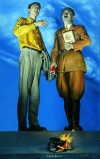National-style Paintings in the Maoist Era
In spite of the fact that the production of “Hotel Art” (art produced for the foreign visitors who began to come to China more frequently after the Nixon visit in 1972) was a rather shortlived affair, its influence was obviously felt in the production of official MaoArt since the early 1970s as well. A rough statistical survey of several Cultural Revolution Poster collections shows that a sample from 1966-1971 would contain only ½ the number of traditional-style images from a sample 1971-1976. While in the first half of the Cultural Revolution, Mao would not be depicted as he still was in propaganda posters from 1962, as part of a traditional festive scene inclusive of drums, drapes and symbolic flowers, for example, in a new New Year Print, he would and could be seen as such again frequently by 1975 (ill.5.36a & b).
While in the first half of the Cultural Revolution, Mao would not appear as he did in 1977, in an ink painting marked by its inscription of calligraphic poetry, he would make a comeback as such already in 1974 (ill. 5.37a & b). A significant sign of a change in acceptability had been given with the opening of an exhibit of “Masterpieces of Chinese Traditional Painting” held at the Beijing Palace Museum (Art and China’s Revolution 2008:240) in 1971, to be continued, in 1973, by the State Council special exhibition of national style painting (Andrews 1994:350).
















































































































